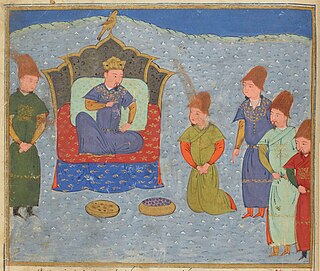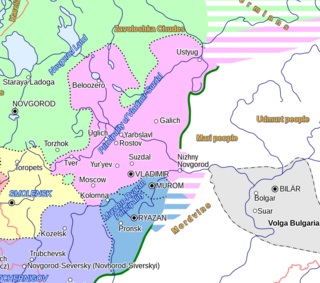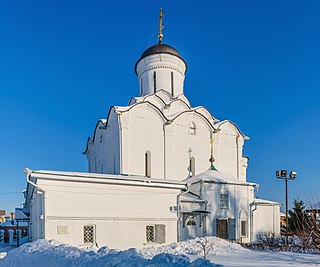
Year 1237 (MCCXXXVII) was a common year starting on Thursday of the Julian calendar.

The Mongol Empire invaded and conquered much of Kievan Rus' in the mid-13th century, sacking numerous cities including the largest such as Kiev and Chernigov. The Mongol siege and sack of Kiev in 1240 is generally held to mark the end of Kievan Rus' as a distinct, singular polity. Many other Rus' principalities and urban centres in the northwest and southwest escaped destruction or suffered little to no damage from the Mongol invasion, including Galicia-Volhynia, Novgorod, Pskov, Smolensk, Polotsk, Vitebsk, and probably Rostov and Uglich.

Batu Khan was a Mongol ruler and founder of the Golden Horde, a constituent of the Mongol Empire. Batu was a son of Jochi, thus a grandson of Genghis Khan. His ulus ruled over the Kievan Rus', Volga Bulgaria, Cumania, and the Caucasus for around 250 years.

Vladimir-Suzdal, formally known as the Principality of Vladimir-Suzdal or Grand Principality of Vladimir (1157–1331), also as Vladimir-Suzdalian Rus', was one of the major principalities that succeeded Kievan Rus' in the late 12th century, centered in Vladimir-on-Klyazma. With time the principality grew into a grand principality divided into several smaller principalities. After being conquered by the Mongol Empire, the principality became a self-governed state headed by its own nobility. A governorship of principality, however, was prescribed by a jarlig issued from the Golden Horde to a Rurikid sovereign.

Yuri II, also known as George II of Vladimir or as Georgy II Vsevolodovich, was the fourth Grand Prince of Vladimir who presided over the Principality of Vladimir-Suzdal at the time of the Mongol invasion of Kievan Rus'.
Yaroslav II Vsevolodovich, also transliterated as Iaroslav, was Grand Prince of Vladimir from 1238 to 1246. He helped to restore his country and capital after the Mongol invasion.

Vsevolod III Yuryevich, or Vsevolod the Big Nest, was Grand Prince of Vladimir from 1176 to 1212. During his long reign, the city reached the zenith of its glory.
Vsevolod IV Svyatoslavich the Red or Vsevolod Chermnyi was Grand Prince of Kiev. He was also Prince of Chernigov (1204–1206/1208) and Belgorod Kievsky (1205). His baptismal name was Daniil.

Michael of Chernigov or Mikhail Vsevolodovich ; c. 1185 – 20 September 1246) was Grand Prince of Kiev ; he was also Prince of Pereyaslavl (1206), Prince of Novgorod-Seversk (1219–1226), Prince of Chernigov, Prince of Novgorod, and Prince of Galicia (1235–1236).

The Battle of the Sit River took place on 4 March 1238 between the Mongol hordes of Batu Khan and the Suzdalians under Grand Prince Yuri II of Vladimir-Suzdal during the Mongol invasion of Kievan Rus'. It was fought in the northern part of the present-day Sonkovsky District of Tver Oblast of Russia, close to the selo of Bozhonka.

The Siege of Ryazan happened Ryazan in December 1237 during the Mongol invasion of Kievan Rus'. Ryazan, capital of the Principality of Ryazan, was the first Kievan Rus' city to be besieged by the Mongol invaders under Batu Khan.

The Principality of Ryazan, later known as the Grand Principality of Ryazan, was a principality from 1129 to 1521. Its capital was the city of Ryazan, now known as Old Ryazan, which was destroyed in 1237 during the Mongol invasions. The capital was moved to Pereyaslavl-Ryazansky, later renamed Ryazan.
Boroldai, also known as Burundai, was a notable Mongol general of the mid 13th century. He participated in the Mongol invasion of Russia and Europe in 1236-1242 and other Mongol raids to Europe until 1263.

Maria Shvarnovna was the first wife of the Yurievichi grand prince of Vladimir Vsevolod III Big Nest, and gave birth to at least 14 children. Four of her sons, Konstantin, George, Yaroslav and Sviatoslav, succeeded their father as Grand Princes of Vladimir, and Yaroslav went on to become Grand Prince of Kiev around the time of the Mongol Invasion. As Yaroslav's mother, she is thus the paternal grandmother of Alexander Nevsky, whose son, Daniel of Moscow, founded the Daniilovichi, the Muscovite branch of the Yurievichi.
The Tale of the Destruction of Ryazan (by Batu) (Russian: Повесть о разорении Рязани Батыем, romanized: Povest' o razorenii Riazami Batyem) is a Russian literary work about the capture of the city of Ryazan by the Mongols in 1237. It is compiled from earlier manuscripts.

The Battle of Voronezh River happened during the Mongol invasion of Kievan Rus'. The Principality of Ryazan was the first to be attacked.

Yury or Yuri Ingvarevich also known as Yuri Igorevich, was Grand Prince of Ryazan from 1235 until his death in 1237 during the siege of Ryazan as part of the Mongol invasions.
The Siege of Kolomna during December 1237–January 1238 was part of the Mongol invasion of Kievan Rus'. Following the Battle of Voronezh River in December 1237, Yuri II of Vladimir sent both of his sons with "all his men" and Voivode Yeremey to defend the fortress of Kolomna, which was on the border to the Wild Fields.
The siege of Moscow in January 1238 was part of the Mongol invasion of Kievan Rus'.
The Mongol siege, capture and sack of Chernigov, capital of the Chernigov Principality, occurred on 18 October 1239 during the westward expansion of the Mongol Empire. It was part of the 1237–1242 Mongol invasion of Kievan Rus'.











